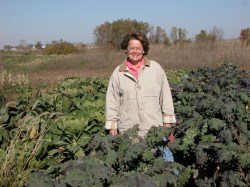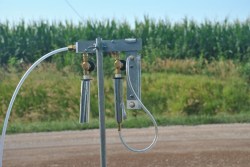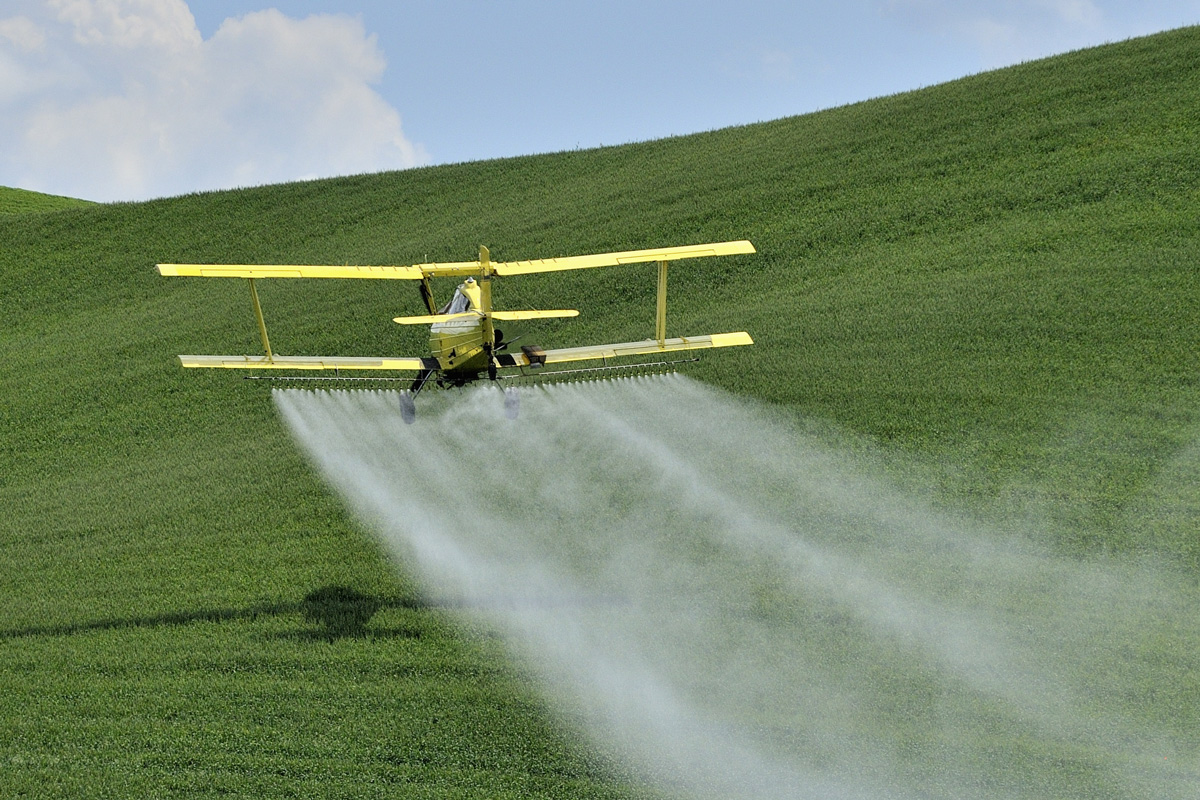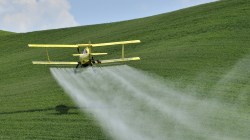When Laura Krouse heard the roar of a crop duster as it flew low, ducking under utility wires to lay down a blanket of herbicides, she sprang into action. Working deftly, she set up a small air vacuum resembling a clothes hanging rod close to her field of vegetables, corn, and hay, not far from where the plane was spraying the neighbor’s 10,000-acre farm. There, it would inhale samples of the air to later be tested to see if the chemicals were drifting onto her land.
Upon seeing Krouse, the pilot circled low enough that she could see his face. His expression read, Just what is that you’re doing, Laura? “He was checking on me,” Krouse says, “and if anyone dare ask, I’d tell them straight out that I’m taking air samples.”
Krouse, who for 25 years has run the 72-acre Abbe Hills Farm in Mt. Vernon, Iowa, is a drift catcher, a toughened breed of farmers who are taking matters concerning the threats of agricultural chemicals into their own hands. She is among 20 Iowa farmers who last winter trained with the California-based Pesticide Action Network (PAN) to use the air monitoring technology PAN specifically designed for laymen. Back home, the farmers took air samples during spraying times throughout this past season.
“I grow vegetables that are susceptible to certain weedkillers, many of which my neighbors use,” says Krouse, who uses organic practices, though her farm is not certified organic. “All it takes is for some of the tomatoes and veggies to get a whiff of a herbicide and they show damage.”

Laura Krouse in a field of kale.
During the summer, Krouse says she’s never out of earshot of crop dusters spraying nearby fields with insecticides and fungicides. The hum of planes and helicopters has become part of the rural fabric. And so have the scent, haze, and invisible vapor clouds of volatilization drift that rise from the soil and surface of plants for days following an application.
“We know we have drift, but how much is unknown,” Krouse says. “I’m measuring because I want to know, and if we find it, I’m saying keep your poison off my farm and out of my air.”
Drift catching is an example of “citizen science,” a movement started by Cornell University scientists the 1980s to help count birds at their feeders during the winter. With their crowdsourced data, ornithologists have been able to monitor and count bird populations across a huge area. Aided by the internet, the technique is also being used in astronomy and with pollinators via The Great Sunflower Project, says Janis Dickinson, a natural resources professor and director of citizen science at the Cornell Lab of Ornithology.
While this is the first year Iowa farmers have measured drift, growers in Hawaii, California, and Minnesota have been monitoring the air, says Linda Wells, PAN’s associate organizing director. Farmers in Wisconsin and Illinois have asked to be added to the drift catching network.
Use and exposure to agricultural sprays have been associated with various types of cancer and neurological disorders, with farmworkers being most susceptible due to their time in the fields during and after applications. The drift is also responsible for diminishing number of bees.
 PAN’s air sampling method is similar to the device used by the California Environmental Protection Agency. As soon as the spraying begins, the drift catchers set up a small device that, in a simple description, acts like a small vacuum, taking in air and depositing residue on internal sponges.
PAN’s air sampling method is similar to the device used by the California Environmental Protection Agency. As soon as the spraying begins, the drift catchers set up a small device that, in a simple description, acts like a small vacuum, taking in air and depositing residue on internal sponges.
Measurements are taken in intervals for several days after an application and are then stored in freezers, sent frozen back to scientists at PAN. The samples are studied for traces of chemicals such as the herbicide 2-4D, and insecticides such as chlorpyrifos and fungicides such as chlorothalonil which is used heavily, for example, on potato crops in Minnesota. Samples taken this season are now being examined by PAN scientists and the results will be released only to the drift catching farmers, says Wells.
What do they plan to do with the results? If testing reveals the presence of drift, they hope to use the information to organize, get more farmers involved in measurement nationally, and work toward changing application procedures and curtailing the use of the more dangerous chemicals. For organic farmers, hard proof may give them legal recourse: When their farms are tainted by drift and crops are damaged, a farm can lose its organic status, and no small amount of its income.
Krouse says the drift catchers can do for crop spraying what was accomplished when the herbicide atrazine was discovered in surface water. Ultimately it led to restriction on the amount of atrazine used on farm fields.
Currently, legal enforcement to prevent drift from reaching neighboring farms is nearly non-existent, farmers say. In Iowa, farmers register their locations with the Iowa Department of Agriculture and Land Stewardship (IDALS) for reference during spraying season, but spray operations don’t use the information consistently. Farmers can register a complaint with the state, but it can take investigators several days to come out to a farm to test for damage, due to a backlog of complaints. By then, the damage is done. Tomatoes planted in June may never recover; the crop and income are lost.
Dustin Vandehoef, a spokesperson for IDALS, says investigators welcome any additional tools farmers might want to use to learn whether drift has occurred on their farms, adding that the agency will still conduct onsite investigations of reported incidents.
Still, farmers are up against forces that are much larger than they are. With huge farms, which often grow fields of the same monoculture crops, it’s often impossible to wait for the perfect spraying weather. “When we’re talking about a 10,000 acre farm, the farmer has to have it sprayed and can’t keep putting it off for a better day or they will lose their crops,” Krouse explains.
And with the continued development of GMOs, farmers are tied into a vicious circle of buying “packages” from companies such as Monsanto that include not only the seed but the pesticide that will rid their crop of nuisance bugs and blights.
“Here in the heartland, we are exposed to endless TV ads by seed companies impressing on us the fantasy that ‘farmers feed the world,’ and need their product,” says Denise O’Brien, who has operated the organic Rolling Acres Farm with her husband in Atlantic, Iowa, for 37 years. “Then they peddle their chemicals that have names like energy drinks — Jolt and Lightning Bolt — and farmers are totally sucked into a situation that they can’t get out of.”
O’Brien, founder the Women, Food and Agriculture Network, hopes that drift catching creates change. “I know it can’t totally stop the spraying. Agriculture in Iowa is king and the big ag companies can do no wrong. But they are doing wrong everyday,” she said. “My goal is that drift catching will expose what is happening so policies and procedures change, making spraying less harmful for farmers and their families.”
A young organic farmer in Poweshiek County, Iowa, says most of his crop was damaged this summer when a neighboring farmer applied a herbicide with a boom sprayer. He makes his living as a CSA farmer and feared he would lose the entire harvest. It’s not uncommon he adds, to see chemicals leaking from crop dusters as they fly overhead.
Drift catching could eventually convince farmers who use chemicals to change their ways, said the farmer, asking that his name not be used. “As word travels that there are farmers in the fields measuring drift, they will think twice, aware that they’re being watched.”




